Orkney
I liked Orkney better. That’s not to say Shetland isn’t worth a visit—it certainly is—but Orkney just had that little something extra, like trees. There are no trees on Shetland, as the soil is too thin and the weather too severe. Also, the area of Shetland where we mostly stayed was the lower part of the main island that is about 20 miles long and 3 miles wide, so you were always aware of being on an island (other parts of Shetland are available), whereas Orkney had the aforementioned trees, rolling hills, and an interior.
However, during our visit, Orkney—like Shetland—was hot.
We settled into our room at midnight, feeling like we had stepped into a pizza oven. In addition to the windows being closed and the curtains open—facing the full force of the afternoon sun—the towel heating rack in the bathroom was on full blast.
I managed to turn off the heater, and we opened the windows, but my wife wouldn’t allow them to be opened enough where they might do some good because an aardvark or something might crawl in during the night. Then, at 5 am, the industrial exhaust fans just outside our room roared into life, so we had to close them all anyway.
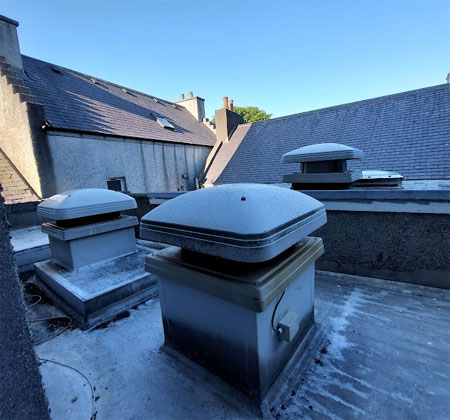
Our very near, very noisy neighbours.
I got up early to try to get some writing done but was thwarted by the room. The bathroom is small and has no place to put anything, and the shower is the worst—though nicest looking one—I have ever encountered. It’s so tiny even I have trouble fitting into it, the plumbing is the most complex I have experienced, and the rickety glass doors slide open every time you touch them (which you cannot help but do). So, after my shower, I had to mop up the entire bathroom (although, as noted above, it’s not that big, so it didn’t take long). Then I returned to the main room.
On first glance, it looks nice, but there is nary a hook in sight, only five hangers in the wardrobe, and very few flat spaces to put things on. With no place to store our suitcases or clothes, we’ve just plunked everything down in the middle of the room. At least there is a tea-making area, but it is stocked with a strange variety of tea flavours—most of which are not something you would want to drink—and there is only one of each. So, I made my wife a breakfast tea, and a cup of instant coffee for myself, using the smallest (but most expensive looking) kettle I have ever seen. Also, the teabags are TeaPigs. I hate TeaPigs.
But it’s a venerable old hotel and it probably cost a bomb to stay here.
After our short night’s sleep, we got an early start (in a vain attempt to stay ahead of the hordes from the cruise ships), heading out to the stone circles of Brodgar and Stenness, lying to the north side of the Orphir Hills (wherever that is). They were impressive, and we did not beat the Cruise Ship tours.

The first stone circle was not that impressive, as there were only three stones.
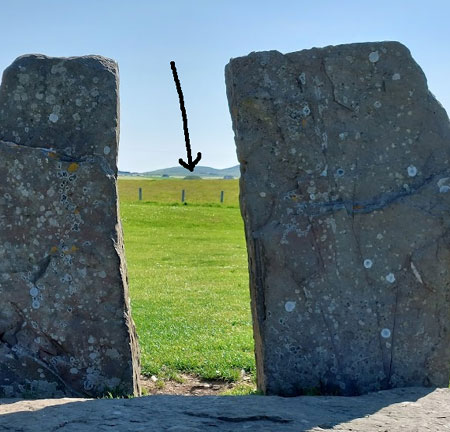
This is the money shot: On a certain day they would look between these two
uprights at the mound in the distance for…some reason or other.

The second stone circle was more of a circle.
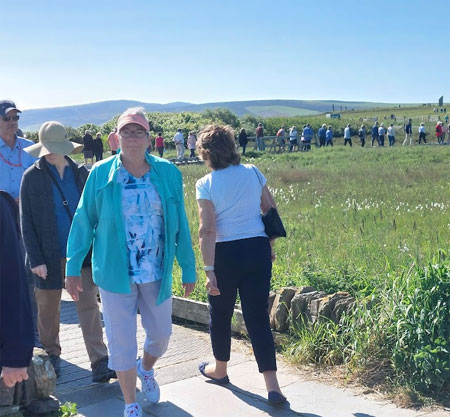
And, therefore, more popular.
The main event of the day was Skara Brae, another ancient village that, like Jarlshof in Shetland, was discovered when a storm ripped the earth off something that had lain hidden for thousands of years. The son of the local Laird, William Watt, was an amateur archaeologist, and spent some time excavating the site (meaning, he plundered what he could, then abandoned it). It is also reported that the daughter of the Laird used the site as a playhouse.
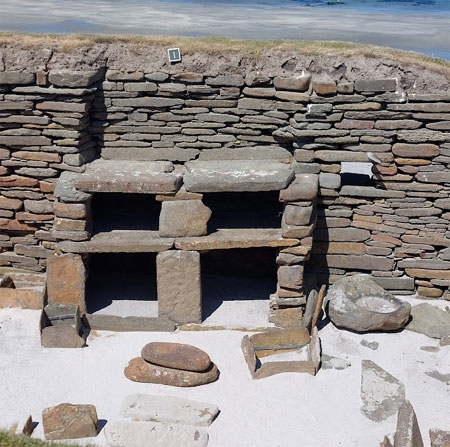
The amazing detail of Skara Brea. Supposedly, it looked
pretty much like this when it was uncovered.
Now, of course, it is recognized as a valuable source of tourist dollars and is, therefore, afforded appropriate protection. Naturally, it was mobbed, so we followed the tours around, listening in and marvelling at the sights. After that, we toured the house (largely on our own) and visited the gift shop and café.

Lots to see, and lots of people to see it.
Our next stop was a little exhibit out in the middle of nowhere, called the Kirbuster Museum. It was a small farm, authentically medieval (so much so that we all left smelling like peat smoke) run by an enthusiastic woman who did a marvellous job of bringing it to life.
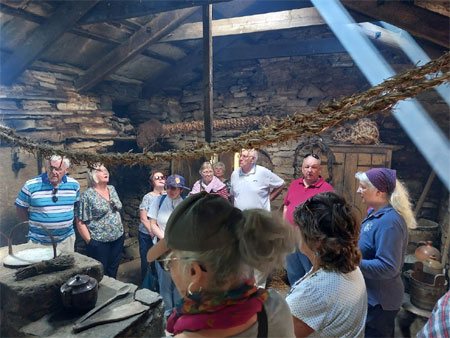
The group inside the farmhouse. Notice the smoke. It did not smell good.
We then went to something called The Broch of Gurness. I was sceptical because we’d already been underwhelmed by a Broch on our first day, but this was truly something special. It was huge, complex and very interesting.

The Broch of Gurness.
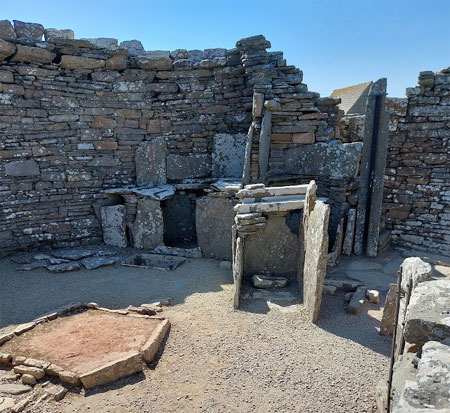
Trust me, it was fascinating even if you don’t like rocks.
Then we returned to Kirkwall and the appropriately (if unimaginatively) named Kirkwall Hotel.
We had Friday morning off, so we took the opportunity to have a good look around Kirkwall, which proved to be a lovely, accessible place. There was the impressive Magnus Cathedral (doubly impressive, if you take into account it’s in Orkney), lots of shops and some lovely architecture.
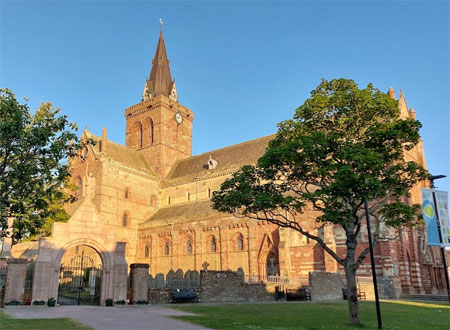
Magnus Cathedral, pretty impressive.
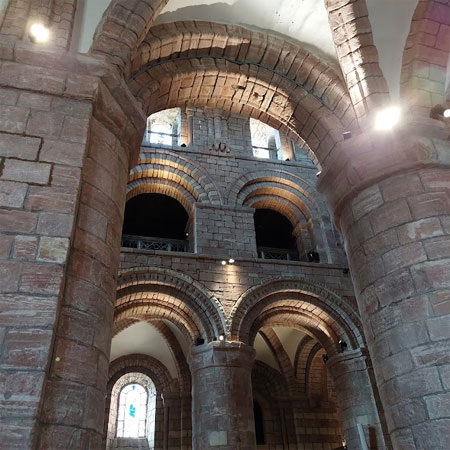
Pretty impressive inside, too.
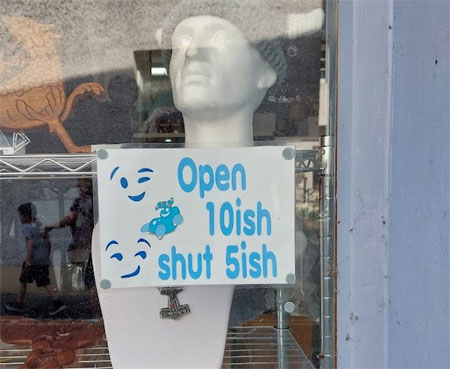
The locals have a casual relationship with time.
In the afternoon, the bus took us to the southern tip of the island, which is connected by the Churchill Barriers across Scapa Flow. These were built during the War (WWII) to keep the Germans out, though why they simply couldn’t go around them I don’t know. They were built in reaction to the sinking of the HMS Royal Oak in 1939, and weren’t finished until after the war, so they never really kept anyone out anyway. What they do now is connect Burray and South Ronaldsay to the main island of Orkney.
However, also on view, as we crossed the causeways, was the remains of the German fleet (which was really what we came for). At the end of WWI, the German fleet, with prisoners of war on board, I believe, was anchored in Scapa Flow. (Scapa Flow is what that area of coastal waters is called. It is not to be confused with Skara Brea, which is on the other side of the island. It does, however, explain why I wandered around Skara Brea all morning thinking, “Okay, I see the prehistoric houses, but where are the German boats?”) Anyway, the Allies were deciding what to do with the ships and the Germans, worried that they might be used against them in the future, scuttled them. The British were not impressed, and they arrested the admiral, but he said he’d do it again. (Well, you would, wouldn’t you.) Of the 74 vessels, 52 were sunk. Only a couple remain now, the others having been taken for scrap. Those that remain have been designated as a heritage sight, so they can’t be moved.
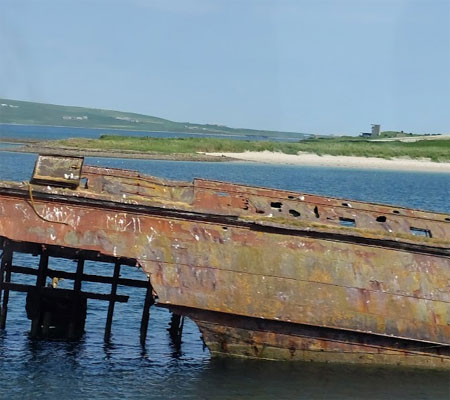
Scuttled German ship at Scapa Flow, not to be confused with Skara Brea.
We then carried on to an amazing little chapel built by Italian POWs. It was built from a Nissan hut but looks like an ornate little church. The prisoners used scrap material and a lot of ingenuity, and the results are stunning.

The Chapel.
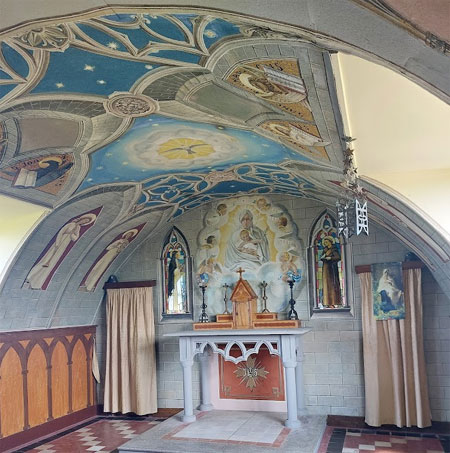
The Alter.
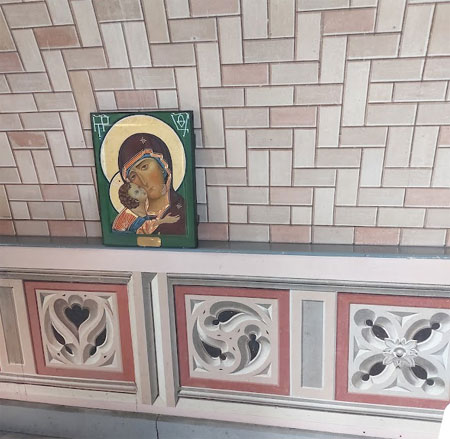
This is not tiling, it is painted to look like tiling, and
even up close it is hard to tell the difference.
The bright, clear, hot weather continued through to the end of our trip. The following day we were up at 4:00 so we could get on the bus at 5:00 and board the ship in Stromness at 6:00. The trip to the mainland (Scrabster near Thurso) only took 90 minutes, and we had to fit breakfast in, so there was a bit of a scrum, but we all manage to get fed before landfall and our return to the bus.

A final farewell to Orkney.
From there, it was a long bus ride to Edinburgh and Glasgow, where we said goodbye to Jason and Sue and all the rest, and went back to the same Premier Inn we had checked out of the previous Monday, still the best hotel we had been in on the entire trip.
One Comment
Ted Ropple
Beware the aardvarks!
Sounds like you had a good trip- thanks for sharing.